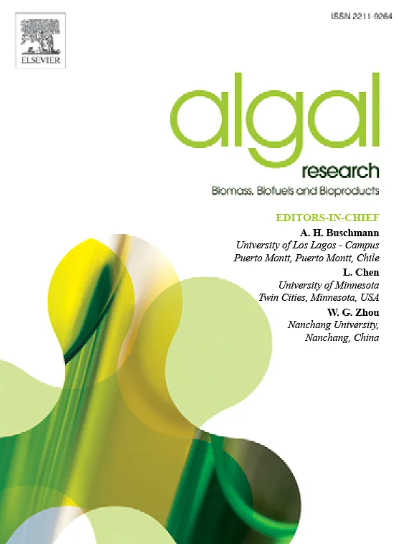Optimization of Nostoc sp. biomass and protein composition in high-density cultivator based on DoE
IF 4.6
2区 生物学
Q1 BIOTECHNOLOGY & APPLIED MICROBIOLOGY
Algal Research-Biomass Biofuels and Bioproducts
Pub Date : 2025-05-09
DOI:10.1016/j.algal.2025.104088
引用次数: 0
Abstract
High-density (HD) cultivation systems are a valuable alternative to improve the productivity of phototrophic microorganisms. They are designed to address the major challenges such as low cell densities, light attenuation, and inefficient gas exchange, offering innovative solutions. This work investigates the HD cultivation of the nitrogen-fixing cyanobacterium Nostoc sp. PCC 7120 under diazotrophic conditions, employing a hydrophobic membrane system for efficient CO2 and N2 transfer. A design of experiment (DoE) approach is applied to evaluate the influence of key operating variables, including light intensity, photoperiod, and phosphorus concentration, on biomass productivity (PX) and nitrogen fixation (PN). Mathematical models, describing the interactions between these process variables and growth responses are developed and validated, enabling the optimization of cultivation conditions to maximise productivity. Remarkable biomass productivity of 1.53 gX L−1 d−1 was obtained in this system, under diazotrophic conditions. PX was largely affected by light intensity, which should be supplied continuously, aligning with the ability of heterocystous species like Nostoc sp. of simultaneously perform photosynthesis and N-fixation. Additionally, phosphorus concentration was a critical parameter that must be precisely controlled to prevent substrate limitation or inhibition, with an optimal value of 34.1 mgP L−1. The produced biomass was further characterised with a focus on its nitrogen-rich molecules, particularly proteins, and nutritional value, assessed through essential amino acid content. The results showed that protein content was improved (53.4 %) at 280 μmol m−2 s−1, 25.5 mgP L−1, and 18 h light period, with essential amino acid ranging between 11 % and 15 %.
基于DoE的高密度栽培菌生物量和蛋白质组成优化
高密度(HD)培养系统是提高光养微生物生产力的一种有价值的替代方法。它们旨在解决电池密度低、光衰减和气体交换效率低下等主要挑战,提供创新的解决方案。本文研究了重氮营养条件下固氮蓝藻Nostoc sp. PCC 7120的HD培养,采用疏水膜系统进行高效的CO2和N2转移。采用实验设计(DoE)方法评估了光强、光周期和磷浓度等关键操作变量对生物量生产力(PX)和固氮(PN)的影响。开发并验证了描述这些过程变量与生长响应之间相互作用的数学模型,从而能够优化培养条件以最大限度地提高生产率。在重氮营养条件下,该体系的生物量生产力达到1.53 gX L−1 d−1。PX受光强影响较大,应持续供应,与Nostoc等杂生物种同时进行光合作用和固氮的能力一致。此外,磷浓度是必须精确控制的关键参数,以防止底物限制或抑制,其最佳值为34.1 mgP L−1。对所生产的生物质进行了进一步的表征,重点是其富氮分子,特别是蛋白质,以及通过必需氨基酸含量评估的营养价值。结果表明,在280 μmol m−2 s−1、25.5 mgP L−1光照18 h下,蛋白质含量提高了53.4%,必需氨基酸含量在11% ~ 15%之间。
本文章由计算机程序翻译,如有差异,请以英文原文为准。
求助全文
约1分钟内获得全文
求助全文
来源期刊

Algal Research-Biomass Biofuels and Bioproducts
BIOTECHNOLOGY & APPLIED MICROBIOLOGY-
CiteScore
9.40
自引率
7.80%
发文量
332
期刊介绍:
Algal Research is an international phycology journal covering all areas of emerging technologies in algae biology, biomass production, cultivation, harvesting, extraction, bioproducts, biorefinery, engineering, and econometrics. Algae is defined to include cyanobacteria, microalgae, and protists and symbionts of interest in biotechnology. The journal publishes original research and reviews for the following scope: algal biology, including but not exclusive to: phylogeny, biodiversity, molecular traits, metabolic regulation, and genetic engineering, algal cultivation, e.g. phototrophic systems, heterotrophic systems, and mixotrophic systems, algal harvesting and extraction systems, biotechnology to convert algal biomass and components into biofuels and bioproducts, e.g., nutraceuticals, pharmaceuticals, animal feed, plastics, etc. algal products and their economic assessment
 求助内容:
求助内容: 应助结果提醒方式:
应助结果提醒方式:


